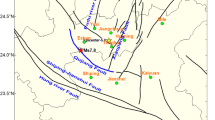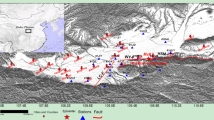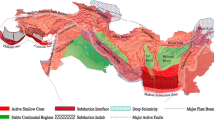Abstract
Uncertainty factors have substantial influences on the numerical simulations of earthquakes. However, most simulation methods are deterministic and do not sufficiently consider those uncertainty factors. A good approach for predicting future destructive earthquakes that is also applied to probabilistic hazard analysis is studying those uncertainty factors, which is very significant for improving the reliability and accuracy of ground-motion predictions. In this paper, we investigated several uncertainty factors, namely the initial rupture point, stress drop, and number of sub-faults, all of which display substantial influences on ground-motion predictions, via sensitivity analysis. The associated uncertainties are derived by considering the uncertainties in the parameter values, as those uncertainties are associated with the ground motion itself. A sensitivity analysis confirms which uncertainty factors have large influences on ground motion predictions, based upon which we can allocate appropriate weights to those uncertainty factors during the prediction process. We employ the empirical Green function method as a numerical simulation tool. The effectiveness of this method has been previously validated, especially in areas with sufficient earthquake record data such as Japan, Southwest China, and Taiwan, China. Accordingly, we analyse the sensitivities of the uncertainty factors during a prediction of strong ground motion using the empirical Green function method. We consequently draw the following conclusions. (1) The stress drop has the largest influence on ground-motion predictions. The discrepancy between the maximum and minimum PGA among three different stations is very large. In addition, the PGV and PGD also change drastically. The Arias intensity increases exponentially with an increase in the stress drop ratio of two earthquakes. (2) The number of sub-faults also has a large influence on various ground-motion parameters but a small influence on the Fourier spectrum and response spectrum. (3) The initial rupture point largely influences the PGA and Arias intensity. We will accordingly pay additional attention to these uncertainty factors when we conduct ground-motion predictions in the future.













Similar content being viewed by others
References
Abrahamson NA, Youngs RR (1992) A stable algorithm for regression analyses using the random effects model. Bull Seismol Soc Am 82(1):505–510
Aki K (1967) Scaling law of seismic spectrum. J Geophys Res 72(4):1217–1231
Annaka T, Ohki H (1992) A sensitivity analysis for seismic hazard estimation. In: Proceedings of the tenth world conference on earthquake engineering, pp 363–368
Atkinson GM, Boore DM (2006) Earthquake ground-motion prediction equations for eastern North America. Bull Seismol Soc Am 96(6):2181–2205
Baiyun L, Daoyang Y et al. (2012) Relation between the source rupture process and surface rupture zone of the M_S7.1 Yushu earthquake. 34(1) (in Chinese)
Beresnev IA, Atkinson GM (1997) Modeling finite-fault radiation from the ωn spectrum. Bull Seismol Soc Am 87(1):67–84
Beresnev IA, Atkinson GM (1999) Generic finite-fault model for ground-motion prediction in eastern North America. Bull Seismol Soc Am 89(3):608–625
Boatwright J (1988) The seismic radiation from composite models of faulting. Bull Seismol Soc Am 78(2):489–508
Boore DM (1983) Stochastic simulation of high-frequency ground motions based on seismological models of the radiated spectra. Bull Seismol Soc Am 73(6A):1865–1894
Boore DM (2003) Simulation of ground motion using the stochastic method. Pure Appl Geophys 160(3–4):635–676
Brune JN (1970) Tectonic stress and the spectra of seismic shear waves from earthquakes. J Geophys Res 75(26):4997–5009
Brune JN (1971) Correction (to Brune, 1970). J Geophys Res 76:5002
Chaolin GU.(2011) Geographical Report of 311 Earthquake in Japan. Acta geographica sinica. 66(6):854–861 (in Chinese)
Cuiping Z, Zhangli C, Sihua Z (2008) Source rupture process of 3 Jiashi Ms6 events (1998~2003) and its correlation with the aftershock activity. China J Geophy (04).(in Chinese)
Dan K, Watanabe T, Tanaka T (1989) A semi-empirical method to synthesize earthquake ground motions based on approximate far-field shear-wave displacement. J Struct Constr Eng Trans AIJ 396:27–36
Das S, Kostrov B V (1986) Fracture of a single asperity on a finite fault: a model for weak earthquakes? Earthq Sour Mech 91–96
Frankel A (1995) Simulating strong motions of large earthquakes using recordings of small earthquakes: the Loma Prieta mainshock as a test case. Bull Seismol Soc Am 85(4):1144–1160
GB18306-2015 Seismic ground motion parameters zonation map of China
Geller RJ (1976) Scaling relations for earthquake source parameters and magnitudes. Bull Seismol Soc Am 66(5):1501–1523
Hanks TC, McGuire RK (1981) The character of high-frequency strong ground motion. Bull Seismol Soc Am 71(6):2071–2095
Hartzell SH (1978) Earthquake aftershocks as Green’s functions. Geophys Res Lett 5(1):1–4
Heaton TH, Helmberger DV (1979) Generalized ray models of the San Fernando earthquake. Bull Seismol Soc Am 69(5):1311–1341
Hough SE, Anderson JG, Brune J et al (1988) Attenuation near Anza, California. Bull Seismol Soc Am 78(2):672–691
Irikura, K (1983) Semi-empirical estimation of strong ground motions during large earthquakes
Irikura, K.(1986). Prediction of strong acceleration motion using empirical Green’s function. In: Proceedings of 7th Japan earthquake engineering symposium. 151–156
Irikura K, Kamae K (1994) Estimation of strong ground motion in broad-frequency band based on a seismic source scaling model and an empirical Green’s function technique. Ann Geophys 37(6)
Irikura K, Miyake H (2011) Recipe for predicting strong ground motion from crustal earthquake scenarios. Pure Appl Geophys 168(1–2):85–104
Kamae K, Irikura K, Pitarka A (1998) A technique for simulating strong ground motion using hybrid Green’s function. Bull Seismol Soc Am 88(2):357–367
Kanamori H (1979) A semi-empirical approach to prediction of long-period ground motions from great earthquake. BSSA 69(6):1654–1670
Kanamori H, Anderson DL (1975) Theoretical basis of some empirical relations in seismology. Bull Seismol Soc Am 65(5):1073–1095
Kanamori H, Brodsky EE (2004) The physics of earthquakes. Rep Prog Phys 67(8):1429
Li ZC, Chen X et al. (2016) Research progress of empirical Green function method simulation strong ground motion. World Earthq Eng (in Chinese)
Li ZC, Chen XL, Gao MT, Jiang H (2016) Simulation near-field ground motion in Kumamoto earthquake, Japan MJMA7.3 by empirical green function method. 5th International conference on civil, architectural and hydraulic engineering (ICCAHE 2016)
Li ZC, Chen X, Gao M et al (2017) Simulating and analyzing engineering parameters of Kyushu earthquake, Japan, 1997, by empirical Green function method. J Seismolog 21(2):367–384
McGuire R K (1988) Engineering model of earthquake ground motion for eastern North America. Electric Power Research Institute
Miyake H, Iwata T, Irikura K (1999) Strong ground motion simulation and source modeling of the Kagoshima-ken Hokuseibu earthquakes of march 26 (MJMA6. 5) and may 13 (MJMA6. 3), 1997, using empirical Green’s function method. Zisin 51:431–442
Miyake H, Iwata T, Irikura K (2003) Source characterization for broadband ground-motion simulation: kinematic heterogeneous source model and strong motion generation area. Bull Seismol Soc Am 93(6):2531–2545
Motazedian D, Atkinson GM (2005) Stochastic finite-fault modeling based on a dynamic corner frequency. Bull Seismol Soc Am 95(3):995–1010
Nolet G (1981) Quantitative seismology, theory and methods. Earth Sci Rev 17(3):296–297
Rabinowitz N, Steinberg DM (1991) Seismic hazard sensitivity analysis: a multi-parameter approach. Bull Seismol Soc Am 81(3):796–817
Rabinowitz N, Steinberg DM, Leonard G (1998) Logic trees, sensitivity analyses, and data reduction in probabilistic seismic hazard assessment. Earthq spectra 14(1):189–201
Sabetta F, Lucantoni A, Bungum H et al (2005) Sensitivity of PSHA results to ground motion prediction relations and logic-tree weights. Soil Dyn Earthq Eng 25(4):317–329
Scherbaum F, Bommer JJ, Bungum H et al (2005) Composite ground-motion models and logic trees: methodology, sensitivities, and uncertainties. Bull Seismol Soc Am 95(5):1575–1593
Shifang X, Li B (2000) A dictionary of earthquake. Seismological Press, Beijing (In Chinese)
Somerville P, Irikura K, Graves R et al (1999) Characterizing crustal earthquake slip models for the prediction of strong ground motion. Seismol Res Lett 70(1):59–80
Stepp JC, Wong I, Whitney J et al (2001) Probabilistic seismic hazard analyses for ground motions and fault displacement at Yucca Mountain, Nevada. Earthquake Spectra 17(1):113–151
Toro GR, McGuire RK (1987) An investigation into earthquake ground motion characteristics in eastern North America. Bull Seismol Soc Am 77(2):468–489
Toro GR, Abrahamson NA, Schneider JF (1997) Engineering model of strong ground motions from earthquakes in the central and eastern United States. Seismol Res Lett 68(1):41–57
Tsuboi C (1956) Earthquake energy, earthquake volume, aftershock area, and strength of the earth’s crust. J Phys Earth 4(2):63–66
Wang Y, Wang B, Dai J (2009) Spatiotemporal distribution characteristics of casualties in great”5·12″Wenchuan earthquake. J Nat Disasters 18(6):52–56 (in Chinese)
Wells DL, Coppersmith KJ (1994) New empirical relationships among magnitude, rupture length, rupture width, rupture area, and surface displacement. Bull Seismol Soc Am 84(4):974–1002
Yang G (2015) Study and application of simulating near-fault ground-motion for moderate-strong earthquake by stochastic finite-fault method. Institute of geophysics, china earthquake administration, Beijing (in Chinese)
Youngs RR, Abrahamson N, Makdisi FI et al (1995) Magnitude-dependent variance of peak ground acceleration. Bull Seismol Soc Am 85(4):1161–1176
Acknowledgements
This research work was supported by the National Natural Science Foundation of China (51678537); the special fund of the Institute of Geophysics, China Earthquake Administration (Grant Number: DQJB18B20; DQJB17B08; DQJB17B02). The earthquake records were obtained from the K-NET network of Japan (http://www.kyoshin.bosai.go.jp/kyoshin/data).
Author information
Authors and Affiliations
Corresponding author
Ethics declarations
Conflict of interest
All authors declare that they have no conflicts of interest
Rights and permissions
About this article
Cite this article
Li, Z., Gao, M., Jiang, H. et al. Sensitivity analysis study of the source parameter uncertainty factors for predicting near-field strong ground motion. Acta Geophys. 66, 523–540 (2018). https://doi.org/10.1007/s11600-018-0171-9
Received:
Accepted:
Published:
Issue Date:
DOI: https://doi.org/10.1007/s11600-018-0171-9




